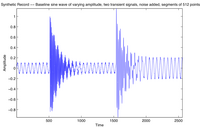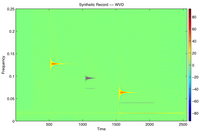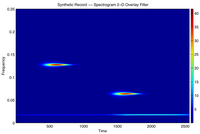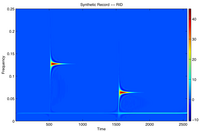2D Filtering of WVD, using Spectrogram Overlay to Eliminate the Interference Terms
This page is now out of date: The current version can be found here.
As discussed, I have been investigating ways to eliminate the Wigner-Ville Interference terms -- these highly oscillitory terms, interference in between different signals, have aliasing behavior in both time and frequency (between two peaks, the WVD will generate an intermediate peak, of similar amplitude, that oscillates between extreme positive and negative values). The interference is largely from the quadratic cross terms embedded in the heart of the WV transform.
Based on earlier discussions, I was looking at ways to create a 2-D filter based on the Continuous Wavelet Transform (CWT), using the Morlet wavelet as my basis. I would then use this 2-D representation as a point-by-point overlay of the WVD, to help eliminate these interference terms. The CWT was unsatisfactory, however, as the resulting wavelet distribution gives a "time-scale" representation, and conversion from wavelet scale to frequency loses some physical meaning. The character of the CWT is slightly shifted in frequency when compared to the "known right answer" as in the Spectrogram, so applying the CWT/Morlet distribution as an overlay will bias the results in the frequency domain.
Recently, based on this overlay concept, I have created a 2-D overlay using a Spectrogram method. By using a running filter and applying a short-time FFT to the synthetic record, I can create a non-biased 2-D overlay -- this overlay can then be used as described above, as our 2-D overlay filter. For this representation, the spectrogram smears the data in the time domain, and does not have proper resolution in time or frequency -- the whole point of moving to WVD-type representations is because the Spectrogram methods are inadequate for exact Time-Frequency resolution!
I'm trying to keep my terminology clear, using "overlay" to refer to my point-by-point multiplication of matrices, and using "filter" to refer to the typical 1-D or 2-D filtering/smoothing, eg., a boxcar or tophat that is convolved with the data.

| SYNTHETIC RECORD
The record is five segments of 512 points each, two transient signals summed with a baseline low-frequency component that doubles in amplitude at the onset of the second transient signal. Each transient decays with the same exponential envelope. (This signal was generated to roughly correspond with an example in Leonowicz et al., 2003.)
[baseline][transient1 + baseline][baseline][transient2 + 2*baseline][2*baseline]
...the baseline is a low-frequency sine wave, with white noise at around 1 part in 50. The transients are enveloped sine waves, with similar noise added to the signal and envelope, to keep this test signal from being too "crisp" to use as an illustrative example.
|

| WVD
Wigner-Ville Distribution of my synthetic signal has the familiar cross-terms, interference in both the time and frequency domain.
|

| OVERLAY
The spectrogram function was used to make a 2-D overlay for the WVD, a matrix of the same dimension of the WVD. This can
effectively remove the cross terms, as the spectrogram is of very small amplitudes in the interference region -- this 2-D overlay, based on the
spectrogram results, contains no negative values since each temporal instant is the amplitude of a windowed Fourier transform. Note that the
spectrogram smears the onset of the signal, so is not by itself able to identify the beginning of the transient signal. |

| WVD WITH 2-D SPECTROGRAM OVERLAY -- "THE ANSWER"
A point-by-point multiplication of the WVD with the 2-D overlay filter. Note that this removes much, but not all, of the interference in both time and frequency.
|

| RID
For comparison with the overlay filter, the RID is equivalent to a 2-D boxcar or "tophat" filter, applied in the kernel of the WV transform. Some interference terms remain, though the vertical alignment of the terms instinctively seems to imply that more optimal smoothing could be performed to better remove these oscillations.
|
case@caltech.edu
Last modified: Sat Oct 1 00:53:40 PDT 2005




